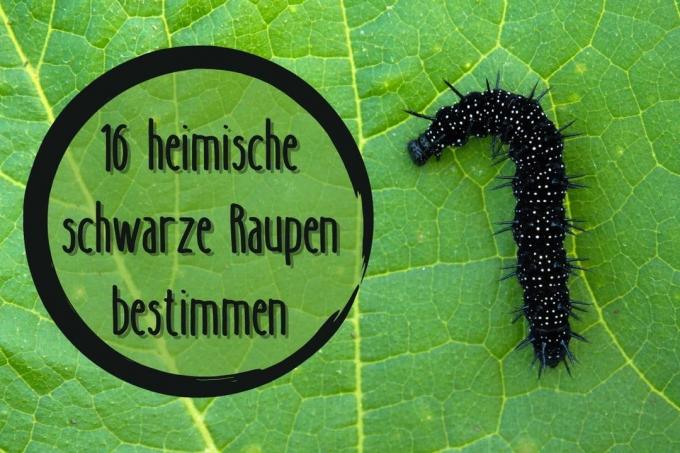
table of contents
- Identify caterpillars
- Noble butterflies
- Owl butterflies
- Cluck
- Stretcher
- frequently asked Questions
Different kinds of butterflies have black colored caterpillars. In some species, the black color only shows in a certain caterpillar stage. The dark color helps them to camouflage themselves or to scare off predators.
In a nutshell
- use distinctive features to identify caterpillars
- Caterpillars can vary their color in different stages
- there are many species with black caterpillars among the owl butterflies
Identify caterpillars
Many species of butterflies can be identified most easily via caterpillars. However, a noticeably large number of native species have black caterpillars. You have to pay attention to the details, especially with black caterpillars.
The following characteristics are relevant for determination:
- Age of the caterpillar
- Hairiness
- Spots or lines
- distinctive projections
- Forage plant
While caterpillars within a particular butterfly family do not need to be the same color, they can have similar characteristics. Therefore, knowing the characteristics of a butterfly family is helpful in identifying the caterpillars.
Note: Caterpillars are very sensitive. Do not touch the insects to determine.
Noble butterflies
The noble butterflies (Nymphalidae) belong to the butterflies. The caterpillars of the noble butterfly usually have hairiness or even thorny or thorny ones. ramified appendages, which make them look very dangerous.
Admiral (Vanessa atalanta)

- Caterpillar season: May - October
- Characteristics: gray-brown to black, thorny, light spots on the sides, spots may be missing
- Forage plants: nettle species, glass herb
Great mother-of-pearl butterfly (Speyeria aglaja)

- Caterpillar season: July - August
- Characteristics: black with reddish rows of dots on the sides, black thorns that are conspicuously long and branchy
- Forage plants: species of violets
Land map (Araschnia levana)
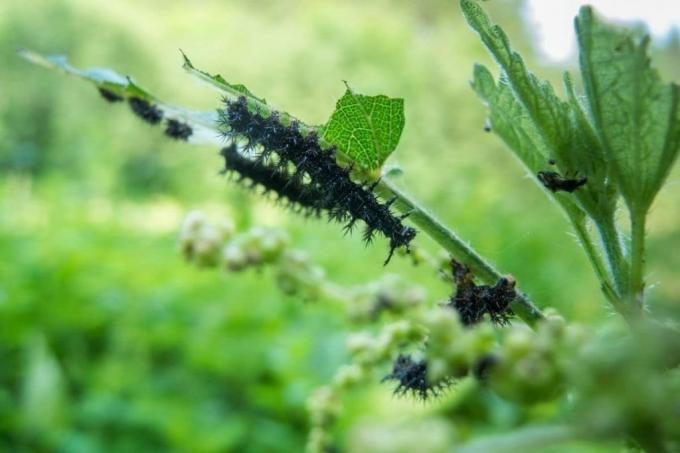
- Caterpillar season: May - September
- Characteristics: black with faded sides and back stripes, tufted hair
- Forage plants: nettles
Scabiosa butterfly (Euphydryas aurinia)

- Caterpillar season: August (overwintering), late April - early May
- Characteristics: black with many small white dots, lighter vertical lines
- Forage plants: pigeon scabiosis, devil bite, cardiac plants
Peacock butterfly (Aglais io)
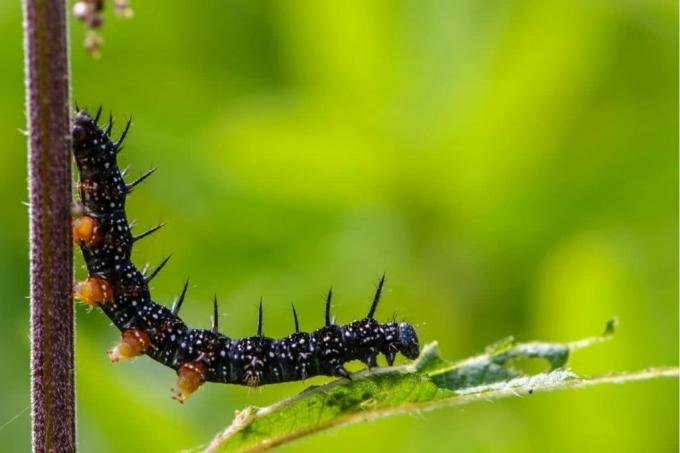
- Caterpillar season: May (overwintering), July - August
- Characteristics: black with many white spots except in the head area, black thorns
- Forage plants: nettle
Owl butterflies
Within the family of the owl butterflies (Erebidae) there is a great variety of both butterflies and caterpillars. Some caterpillars of this genus even have extremely long hair, while others have poisonous stinging hairs.
Spring lichen bear (Eilema sororcula)

- Caterpillar season: July - September
- Characteristics: black basic color with gray and white pattern, reddish-brown warts, long, thin hair
- Forage plants: lichens (mainly growing on deciduous trees)
Red-collar lichen bear (Atolmis rubricollis)
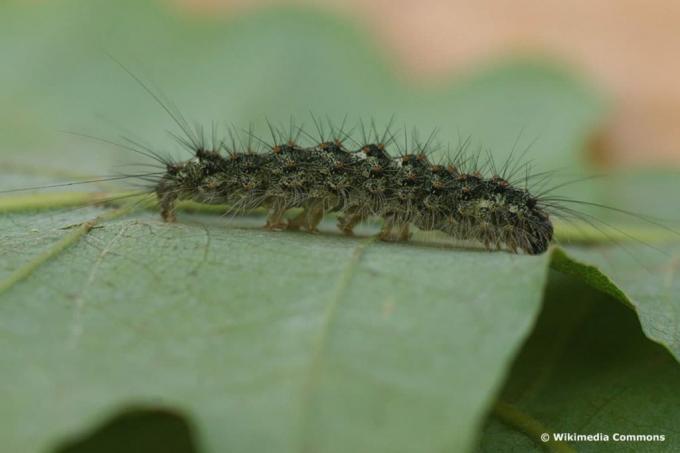
- Caterpillar season: August - September
- Characteristics: dark gray to black basic color, yellowish marbled, reddish point warts with tufts of hair
- Forage plants: lichens growing on deciduous and coniferous trees, mainly common yellow lichen
Reddish cat-owl (Orthosia miniosa)

- Caterpillar season: May - June
- Characteristics: black only when young, later yellow-black longitudinal stripes, hairy
- Forage plants: oak, hawthorn
Satellite winter owl (Eupsilia transversa)

- Caterpillar season: May - June
- Features: black-brown or black with a slight purple tint, lighter back and side lines
- Forage plants: trembling aspen, willow, hazel, common beech, common oak
Blackthorn brush spinner (Orgyia antiqua)

- Caterpillar season: May (overwintering), end of July - August
- Characteristics: black only when young, noticeably long hair, later red and black patterned segments on the back
- Forage plants: blackthorn, hawthorn, raspberry, rowanberry, willow
Fairy bear (Callimorpha dominula)
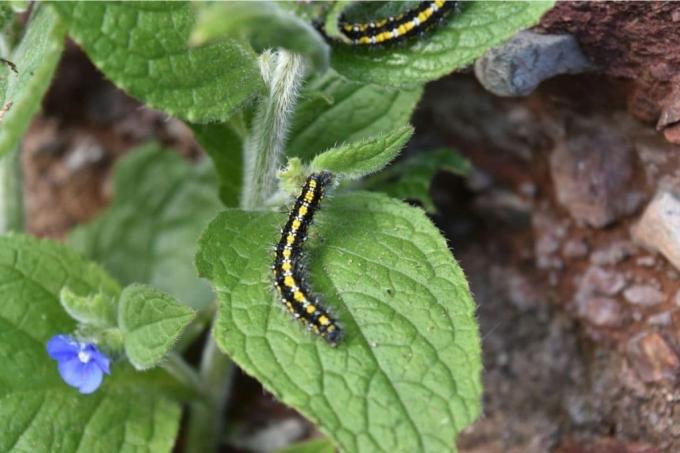
- Caterpillar season: autumn (overwintering) - June
- Characteristics: dark gray to black with yellow stripes and white spots on the side, black hair
- Forage plants: raspberry, willow, hazel, nettle, plantain
Plantain bear (Arctia plantaginis)
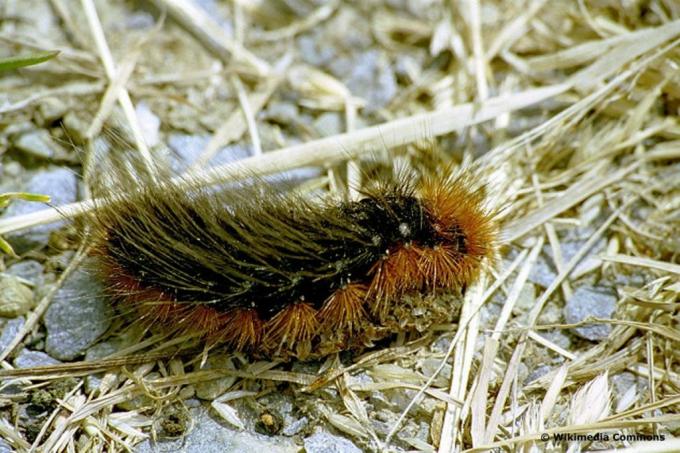
- Caterpillar season: August - May (overwintering)
- Characteristics: black-gray, black and fox-red densely hairy
- Forage plants: plantain species, dandelions, sorrel
White tiger moth (Spilosoma lubricipeda)
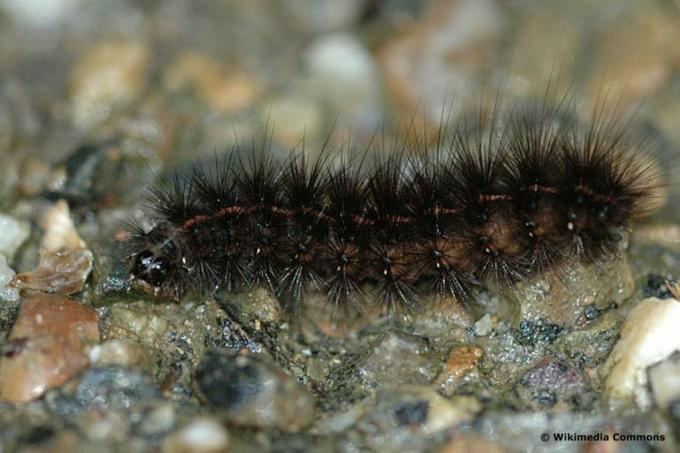
- Caterpillar season: July - September
- Characteristics: dark gray to black, with reddish stripes on the back, strong dark brown to black hair
- Forage plants: dandelion, nettle, alfalfa, adder's head, plantain, blackberry, raspberry
Cluck
Many colors are represented in the caterpillars within the butterfly family of the mother hen (Lasiocampidae). In addition to black specimens, there are also brown or colored caterpillars with turquoise stripes. Huckling got its name because the adult moths look like chickens when they sleep, like chickens protecting the chicks under themselves. They are twilight resp. nocturnal and easy to observe in artificial light. The caterpillars are mostly specialized in certain food sources, which is not infrequently eponymous for a species. However, they can also become pests if they appear en masse from their food sources.
Blackberry Moth (Macrothylacia rubi)

- Caterpillar season: April - September
- Characteristics: in the young stage almost completely black, later black basic color with bright yellow or orange horizontal stripes, with age increasingly brownish, hairy
- Forage crops: blackberries, sloes, raspberries, clover, vetches
Note: Contact with the hair of the blackberry moth can lead to allergic reactions.
Hawthorn moth (Trichiura crataegi)

- Caterpillar season: May - July
- Characteristics: black to brownish color with yellow segments, warts on the back, irregularly haired
- Forage plants: hawthorn, birch, oak, willow
Stretcher
The name of the Spanner family (Geometridae) is the form of locomotion of the caterpillars. Due to the few pairs of legs, the caterpillars move on as if they were spanning again and again.
Blueberry pacifier (Hydriomena furcata)
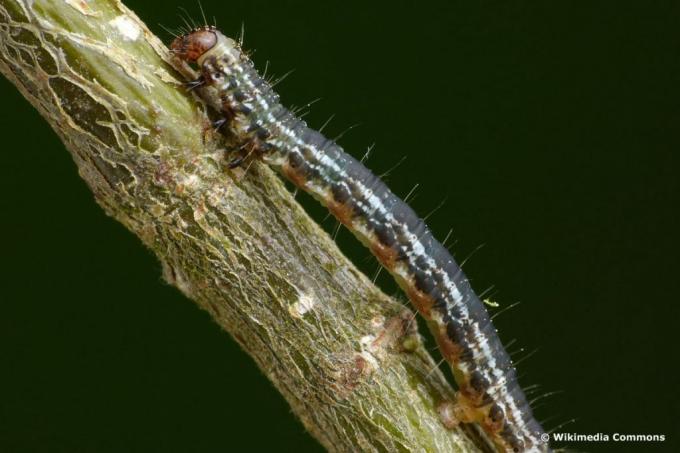
- Caterpillar season: April - early July
- Characteristics: dark gray to black coloring, white side stripes
- Forage plants: Blueberry, Sal willow, hazel, roses
During the day, the caterpillars of the blueberry palpebrate spin shoot tips or Leaves together in which they rest.
frequently asked Questions
Not all hairy caterpillars cause an allergic reaction. If you have not yet been able to clearly identify the caterpillar, wash off the affected area and observe it. If you get a violent reaction, see your doctor.
Yes, the caterpillars of the peacock butterfly can occur in large groups. When overwintering in the caterpillar stage, some species also form nests together.
Thorny appendages serve only to deter predators. Compared to the hair, these appendages cannot be poisonous.
